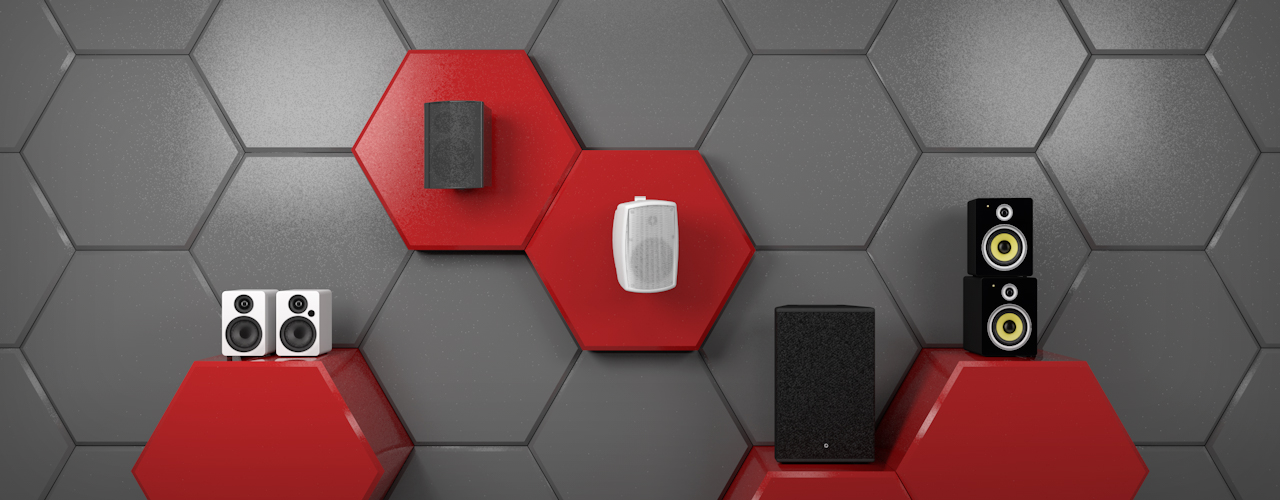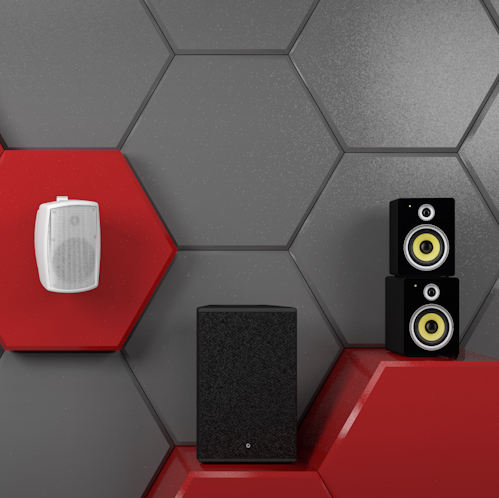
Low-impedance speakers: where are they used and what distinguishes them from 100 V technology
There are two types of speakers, low-impedance speakers and high-impedance, e.g. 100 V, speakers. But what exactly is behind this? In what ways do they differ and where are they used? Let us explain.
Low-impedance and high-impedance speaker systems: what is behind this?
We distinguish between two different versions of speaker systems: low-impedance and high-impedance. This means that the internal resistance of the speaker is either low (i.e. of low impedance) or high (i.e. of high impedance). The internal resistance (or AC resistance) is also called impedance. Both low-impedance and high-impedance speaker systems use low-impedance speakers, which normally have an impedance between 4 and 16 ohms. Only through the preceding transformer, the 100 V speakers become of high impedance. The impedance value depends on the power selected at the transformer. A 100 V speaker with a power capability of 10 watts, for example, has a load impedance of 1 kΩ, at 1 watt it is 10 kΩ and at 100 watts 100 Ω.
low-impedance speakers | high-impedance speakers (100 volt technology) |
mostly impedances of 4, 8 or 16 Ω | impedance depends on the input of the preceding transformer |
are directly connected to the output of the amplifier | have a preceding transformer |
Where are low-impedance speaker systems used?
Low-impedance speakers
Low-impedance speakers are always used where few speakers and short cable lengths are required. Accordingly, they are suitable for direct connection to an amplifier and can be used in single rooms or smaller buildings. In a low-impedance system, standard speaker cables can be used. The disadvantage of low impedance: significantly fewer speakers can be operated at one amplifier output.
Examples:
A classic example of low-impedance technology is the PA application at home. Here, speakers with an impedance of 4 to 8 ohms are normally used. Regardless of whether the home is equipped with a classic pair of stereo speakers or a surround system, the cable paths are short, so both versions are based on low impedance. In a surround system, for example, each speaker has its own connection to the amplifier.
Low-impedance technology is also often used in classical stage technology. With high-impedance speaker systems, very low frequencies may be transmitted at a lower volume or not at all if the quality of the coils is not high enough.
Installers can also use low impedance (plus a small amplifier) in classrooms. In recent years, digital media have been increasingly used here, for example, with beamers and wireless microphones. In this case, one low-impedance speaker each to the left and right of the blackboard is sufficient. On the other hand, 100 V technology would make more sense in a school building if the classrooms are to be addressed from the administration office or the principal's office (examples: announcements or recess gong). This would require many more speakers (in corridors, the staff room, the break hall, the schoolyard, etc.), which would result in longer cable paths.
100 V technology
High-impedance speakers are always used in PA applications where long cable lengths are required and many speakers are used. In a 100 V installation, you need a double insulated cable approved for 100 V. 100 V (i.e. high-impedance) systems are advantageous for large or extensive buildings because they have a higher audio signal voltage and therefore lower losses on the cable paths.
Examples:
Classic examples are schools, department stores, larger companies and gyms, i.e. large buildings in which central announcements are to be made or background sound is required. The 100 V technology is suitable for this because it transforms the voltage that runs through the transformers to a higher value. This makes it possible to bridge longer distances with less loss. We have written about the 100 V technology in detail here.
Basically, there is no difference between low-impedance technology and 100 V technology in terms of quality. This means, the technology itself is not important, the quality of the speaker (and the transformer) is essential.
Are you planning PA applications for a retail shop?
Are there price differences between low-impedance speakers and 100 V technology?
High-impedance speakers are usually a little more expensive. Ultimately, low-impedance and 100 V systems are identical in their construction, they have the same cabinet, the same crossover network, the same speakers and much more. The only difference is
that in 100 V speaker systems, a transformer is installed, which costs extra.
What has to be considered when installing low-impedance systems?
The minimum impedance
The power of the speaker should correspond with the amplifier. With low-impedance technology, specific attention should be paid to the following: the load impedance, i.e. the minimum impedance of an amplifier, must not be undercut. There are amplifiers that can only tolerate 8 ohms without damage, but most can also tolerate 4 ohms. To clarify, if you connect two 4 ohm speakers to a 4 ohm stereo amplifier, it will work perfectly. If, however, you want to install not just two speakers in a room, but four, it becomes more difficult. If you connect two 4 ohm speakers (in parallel) per channel, the result is 2 ohms. The impedance is too low, which will damage the amplifier. If you connect the speakers in series instead, two 4 ohm speakers become 8 ohms - that does not affect the amplifier.
A higher impedance is no problem. However, the impedance must not be lower
than the minimum impedance indicated on the amplifier.
- Series or parallel connection: is it variable?
Whether you connect low-impedance speakers in series or in parallel depends on the respective impedance of the speakers as well as the minimum impedance of the amplifier. If you have two 8 ohm speakers, you can easily connect them in parallel and connect each channel to a 4 ohm amplifier. However, if you have two 4 ohm speakers, you should connect them both in series to avoid undercutting the minimum impedance.
- The polarity of the speakers
The polarity must be the same for all speakers. This means, plus to plus and minus to minus. Otherwise, the different frequency ranges will work against each other, and in the worst case they will even cancel each other out. In other words, if you reverse the polarity, the result will be unnatural sound and reduced bass reproduction with poor or incorrect sound transmission.
How does an installer know which speakers are required?
You decide which speakers you need on the basis of the customer's wishes and the construction plans at hand. Questions like these help:
Purpose:
- What does the user want to do with the speakers?
- What should the speakers look like? For example, what colour and shape should they have?
- What is the room like? For example, are the ceilings high? (In that case, flush-mount speakers or ball speakers, which are suspended from the ceiling, are a good choice.) Or are the ceilings made of concrete? In that case, wall speakers will be used.
- Also relevant: should the speakers be visible or blend perfectly (or even invisibly) into the room concept?
Are you curious and would like to learn more about PA technology? Then feel free to browse through our magazine.


